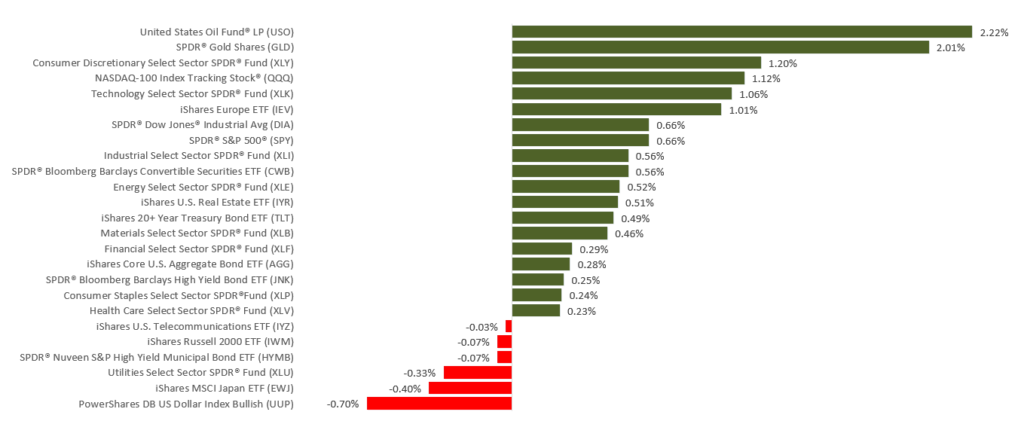
The Weekly Update
Week of December 20th, 2019
By Christopher T. Much, CFP®, AIF®

What Drove the Markets?
Four factors influenced investment performance in 2019: a shift in U.S. monetary policy, the ongoing trade dispute between the U.S. and China, earnings, and the economy.
Stocks reached record highs in 2019. The S&P 500 climbed above 3,000 for the first time. The benchmark ended Friday’s trading session up 29.25% for the year. At Friday’s close, the Dow Jones Industrial Average showed a year-to-date advance of 22.95%, while the Nasdaq Composite was up 35.74% YTD. The MSCI EAFE index, representing foreign stocks, was up 18.10% YTD through December 27.
The Federal Reserve Eased
The central bank made three quarter-point cuts to the benchmark short-term interest rate in 2019. That was a change from 2018, when the Fed worked on normalizing monetary policy with interest rate increases, while thinning its large bond portfolio.
By and large, investors welcomed the policy shift. At the end of 2018, there were concerns that the Fed’s effort to tighten the money supply had backfired, with higher U.S. interest rates impeding both the domestic and global economy.
The U.S. and China Trade Quarrel Cooled Down Slightly
In December, representatives from both nations agreed on a “phase-one” trade deal after a year-and-a-half of imposing tariffs on each other’s products. This pact, which is expected to be signed in 2020, is characterized as an initial step toward a larger deal.
In May, the U.S. put 25% tariffs on $200 billion of Chinese imports; a month later, China imposed a 25% import tax on $60 billion of U.S.-made goods reaching its shores. These tariffs may be reduced or removed as part of the phase-one deal. (Another $120 billion worth of Chinese goods are currently under a 7.5% tariff, reduced from 15% by the new agreement.)
Earnings Beat (Low) Expectations
Stock market analysts were pessimistic about corporate profits as the year began. With economies worldwide slowing down in 2018, year-over-year earnings growth for S&P 500 firms seemed poised to decelerate.
Deceleration was evident, but later in the year, many firms managed to exceed reduced estimates. According to stock market analytics firm FactSet, 75% of S&P 500 components beat earnings-per-share estimates in Q3, compared to a 5-year historical average of 72%.
The Economy Maintained Momentum
Gross domestic product came in at 3.1% in Q1, 2.0% in Q2, and 2.1% in Q3. Through November, nonfarm payrolls growth had averaged 180,000 per month during 2019. Manufacturing output varied, as CEOs were less certain about expansion and capital investments in the first half of the year; it declined in Q1 and Q2 before improving again in Q3.
The Conference Board’s consumer confidence index was at 125.5 in November, above its (revised) January mark of 121.7. Inflation stayed under 2% for most of the year before reaching a 12-month high of 2.1% in November.
What’s Ahead
Congress passed the Setting Every Community Up for Retirement Enhancement (SECURE) Act before Christmas, and President Trump signed it into law last week. This new law alters a key rule pertaining to traditional retirement accounts. It raises the age for Required Minimum Distributions (RMDs) from these accounts, from 70½ to 72. (If you are now 70½ or older, this change does not affect your scheduled RMDs. Only those who turn 70½ in 2020 or later are subject to the new rule.)
THE WEEK AHEAD: KEY ECONOMIC DATA
Tuesday: The Conference Board publishes its last monthly Consumer Confidence Index of 2019.
Friday: The Institute for Supply Management presents its December manufacturing index, a gauge of U.S. factory activity.
Source: Econoday, December 27, 2019
The Econoday economic calendar lists upcoming U.S. economic data releases (including key economic indicators), Federal Reserve policy meetings, and speaking engagements of Federal Reserve officials. The content is developed from sources believed to be providing accurate information. The forecasts or forward-looking statements are based on assumptions and may not materialize. The forecasts also are subject to revision.


